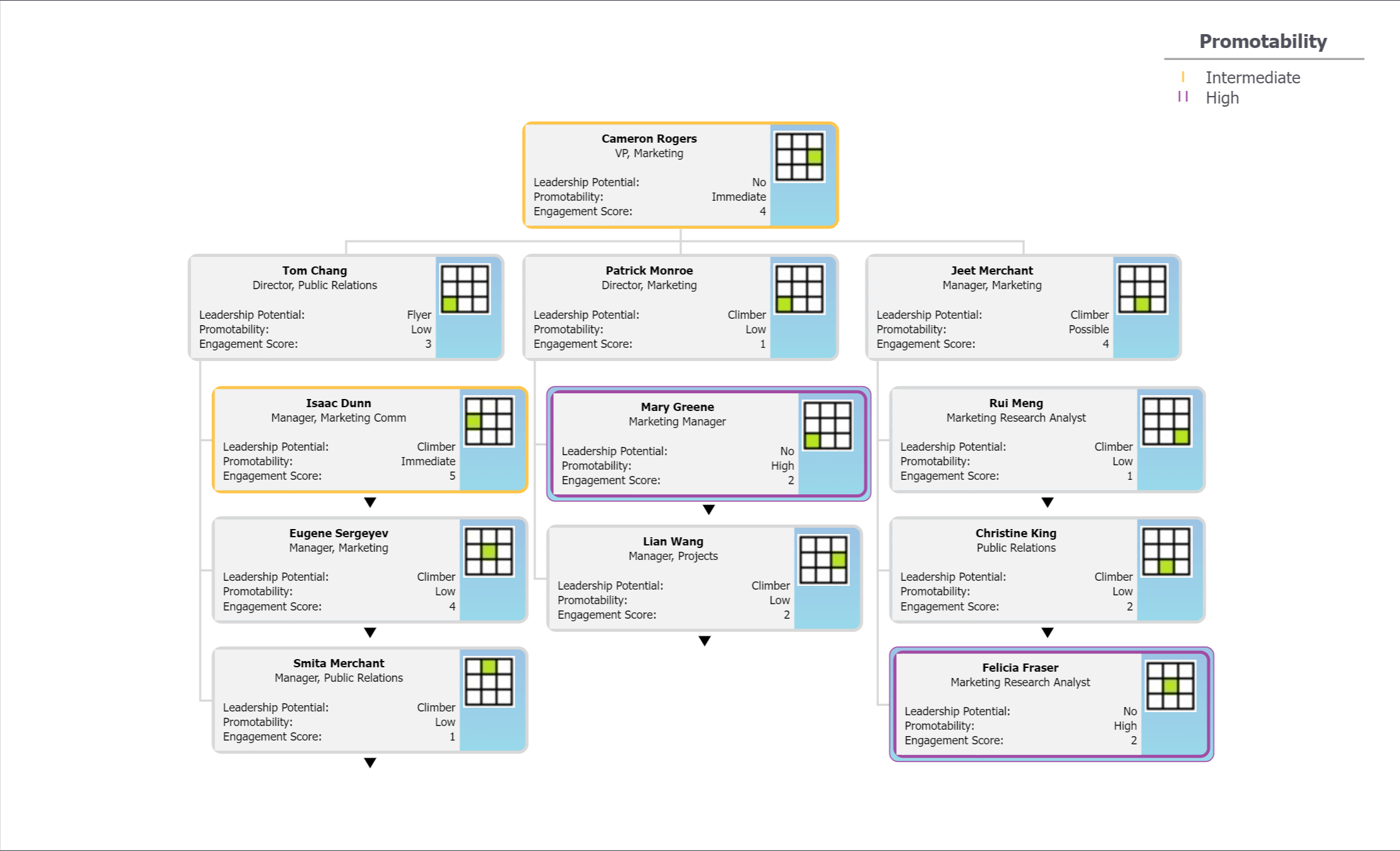Succession planning isn’t merely a reactionary measure for filling leadership gaps. Instead, it’s a proactive approach to guaranteeing organizational continuity.
The process involves identifying and developing employees with the potential to assume key roles in the future. This forward-thinking strategy not only mitigates the risks associated with sudden leadership changes but also aligns with the broader goals of talent management.
Despite its undeniable importance, effective succession planning is often hindered by common challenges. From the lack of a standardized approach to difficulties in accurately assessing employee potential, organizations often encounter various obstacles that impede the seamless execution of their succession plans.
Below, we highlight helpful HR succession strategies and the tools you need to plan and fill effectively.
1. Use Talent Pipeline Management for Dynamic Succession Planning
Organizations must embrace a proactive approach to identify, nurture, and retain top talent. Central to this approach is the concept of talent pipeline management, a strategic process that ensures a continuous flow of skilled individuals ready to assume key roles within the organization.
Below are four tactics leaders can implement to start a successful succession planning process:
- Proactive Talent Identification and Development: Implement a continuous talent identification and development strategy that extends beyond immediate leadership needs. By identifying and nurturing talent at all levels of the organization, companies build a robust pipeline that extends beyond immediate succession planning requirements.
- Alignment with Organizational Goals: Align talent pipeline management with the broader organizational strategy and objectives. A talent pipeline that mirrors the organization’s goals ensures that the right skills are developed and nurtured.
- Employee Development Tools for Skill Enhancement: Leverage employee development tools to enhance skills and foster continuous growth. Employee development tools – which encompass training programs, workshops, and mentorship initiatives – play a pivotal role in enhancing the capabilities of individuals within the talent pipeline.
- Cross-Functional Exposure and Rotational Programs: Implement cross-functional exposure and rotational programs to broaden the skill sets of potential successors. Rotational programs contribute to a well-rounded skill set, making individuals better equipped to step into leadership positions seamlessly.
Trusted By Thousands to Chart Millions
2. Invest in Succession Planning Software to Help Navigate Leadership Development
It’s no secret that succession planning helps organizations sustain their competitive edge. In fact, studies show that lack of succession planning costs the S&P1500 $1 trillion a year.
Succession planning software has emerged as a key enabler, providing HR professionals with advanced capabilities to identify, nurture, and manage talent within the organization. Moreover, successful planning results in strategic talent identification, reduced time-to-fill leadership gaps, enhanced employee engagement, and data-driven decision-making.
As you search for the right succession planning software, consider the following:
- Talent Database Management: Succession planning tools serve as a centralized repository for employee information, including skills, competencies, and performance data. This feature allows HR professionals to easily identify high-potential individuals.
- Skills Assessment and Gap Analysis: The software facilitates a comprehensive evaluation of employee skills against the requirements of key roles. This helps in identifying skill gaps and formulating targeted development plans.
- Succession Scenarios and Planning: Organizations can simulate various succession scenarios to assess the readiness of potential successors. This feature aids in creating detailed succession plans with a focus on smooth transitions.
- Collaborative Decision-Making: Many platforms offer collaborative features, allowing HR teams and leadership to collectively evaluate and discuss potential successors. This ensures a more inclusive and well-informed decision-making process.
- Integration with Performance Management: Seamless integration with performance management systems enables a holistic view of an employee’s performance, making it easier to align succession plans with overall workforce development strategies.
Of course, not all succession planning technologies are made the same, which is why it’s important to determine what features are must-haves for your organization. Many companies prefer software that also scales with their organization’s growth, provides seamless integration with their other HR systems, allows customization to align with unique succession planning requirements, and enhanced security and compliance features. When searching for a succession planning tool, make sure you consider your organization’s needs and goals.

3. Master the 9-Box Grid to Assess Talent
The 9-box grid stands as an invaluable tool for HR professionals seeking to assess and strategically position their organization’s talent. This grid, often known as the performance-potential matrix, provides a visual representation of employees based on their current performance levels and their potential for future growth.
The 9-box grid typically consists of two axes: the performance and the potential axes. The performance axis assesses an employee’s current performance level, often measured against key performance indicators (KPIs) or other relevant metrics. It ranges from low to high performance. The potential axis evaluates an employee’s capacity for growth and development. It considers factors such as skills, adaptability, and leadership qualities, ranging from low to high potential.
Using the 9-Box Grid for Succession Planning
The 9-box grid divides the talent pool into nine distinct categories, each representing a unique combination of performance and potential:
- High Performers, High Potentials (Top Right): Employees in this quadrant are considered top talent, excelling in both their current roles and exhibiting strong potential for future growth. They are prime candidates for leadership positions.
- High Performers, Low Potentials (Top Left): While these individuals excel in their current roles, they may have limited potential for growth beyond their current positions. Consideration should be given to how to best leverage their existing skills.
- Low Performers, High Potentials (Bottom Right): Individuals in this quadrant have demonstrated potential for growth but are currently underperforming. Strategic development plans may be necessary to improve their current performance.
- Low Performers, Low Potentials (Bottom Left): Employees in this quadrant may require close attention, as they exhibit both low performance and limited potential. Decisions regarding performance improvement or alternative roles may be necessary.
To effectively use the 9-box grid, conduct regular talent review sessions to update the grid based on the latest performance reviews and potential assessments. Doing so – as well as hosting collaborative collaboration sessions involving key stakeholders – helps ensure a fair and unbiased assessment of employees.
By mastering the 9-box grid, HR professionals can navigate the complexities of talent assessment and succession planning with precision. The grid serves as a strategic compass, guiding organizations in identifying, developing, and retaining top talent for sustained success.
How OrgChart Can Help
Ready to start your data-driven succession planning journey? See the difference OrgChart can make.
This succession planning tool gives leaders a birds-eye and granular view of their organization, allowing them to identify top performers and develop growth opportunities for those individuals. And since everyone has access to the up-to-date org chart at all times, succession planning becomes an efficient and collaborative process. Additionally, OrgChart’s forecasting feature allows leaders to see different variations of plans, which further helps them prepare for significant staffing changes.
Ultimately, with OrgChart, you’re not merely safeguarding your company’s future, but choosing a platform that fits your organization’s unique needs and creates a foundation for continued success.
Increase visibility to guide the future of your organization with OrgChart. Book a demo today to learn how comprehensive, transparent org charts can drive your organization’s success.

-
“Connects directly to our HRIS and updates on a normal cadence — we choose daily. You can also update as needed. Took several hours a month of org chart planning off of our plates … the ROI in terms of time spent is fantastic.”
Verified User in Pharmaceuticals,
Mid-Market (51-1000 emp.)
-
“It’s great for seeing our entire organization in a few clicks.”
Jason G.,
Enterprise (> 1000 emp.)
-
“Extremely easy to implement and use. Easy and fast to create charts, allowing the information to be always updated and even better, customised.”
Carolina F.,
Sales Operations Lead
-
“OrgChart creates a perfect org chart that’s easy to update every time. Saves battling with MS Visio every time there a staffing change.”
Leo C.,
Managing Director Mid-Market (51-1000 emp.)
-
“The only comprehensive Org Chart software! Easy to set up templates, upload information, and build comprehensive charts. We have used the software to understand the span of control and ultimately organizational design.”
Jillian P.,
Head of Talent Acquisition & Onboarding Mid-Market (51-1000 emp.)
-
“OrgChart is taking our very manual org chart creation and making it easier to make changes. We were also able to easily add the new photos we took of all employees.”
Jacqueline W.,
Mid-Market (51-1000 emp.)

